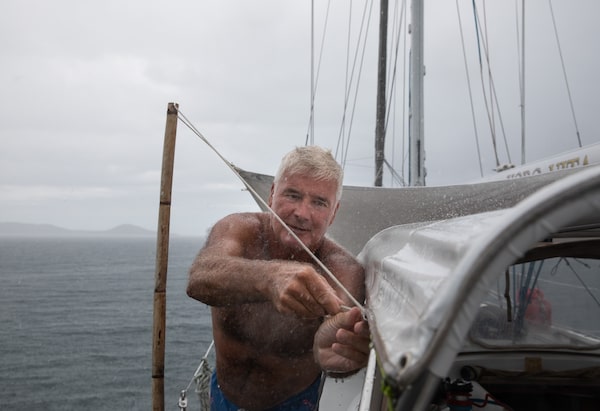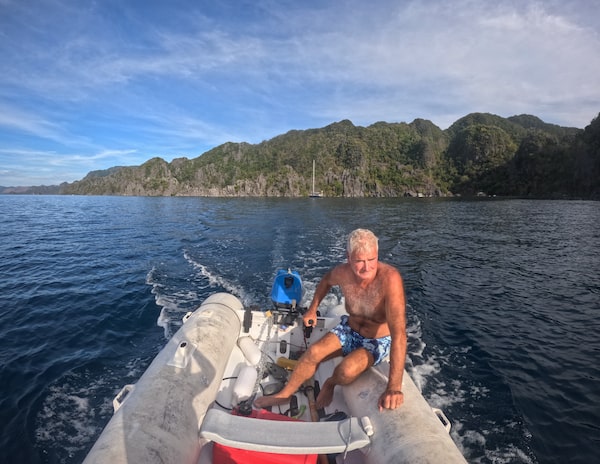Jessica Lee steering on Don Salthouse's boat near Coron, The Philippines. She learned to follow a boat tracker during this trip with his help.Jessica Lee/The Globe and Mail
I am underwater in a secluded mountainous enclave of lush forest in the Philippines, watching coral open and shut their mouths as the occasional fish swims by. The waters, a few nautical miles from the coast of Coron on Busuanga Island, are turquoise and shimmering under a bright, clear sky.
Floating a few feet away from me is Don Salthouse, a retired Kiwi sailor in his 60s undertaking a (mostly) solo sailing trip around the world in his 53-foot classic keel boat, the Caro Vita. We’ve just finished a breakfast of pancakes and fresh fruit onboard and are now exploring.
Salthouse and I are, essentially, strangers. Yet I wouldn’t be here right now if not for him.
I am travelling by myself around Southeast Asia. A few days ago, I found Salthouse through a Facebook group where captains post requests for help on their boats and travellers offer their sailing skills and experience. The two parties either agree to share costs for fuel and food, or the captain provides it in exchange for labour, depending on the type of trip and the amount of sailing experience crew members have. Since I grew up sailing – even doing it competitively during my university years – I thought I’d give it a try.
When I saw Salthouse’s post, we were both already in the Philippines: I was on El Nido, an island just a boat ride away from Cebu, where he was arriving. He had spent the previous few months sailing through the South Pacific with a friend of his daughter’s.
I had been on El Nido for a week by then. While I was enjoying being by myself, I had already kayaked to the surrounding beaches, scuba dived to the bottom of the sea a handful of times, walked around the entire area, studied the night market, sampled all of the local foods and suntanned, day after day.
In his post, Salthouse said he was heading south toward Malaysia and, eventually, Singapore. During the trip, he realized he enjoyed sharing the experience much more than being solo. He added that he had raised four daughters and wanted to give other women the chance to become a captain and sailor. The first comment on Salthouse’s post was a reference from a young woman calling him amazing and respectful.
I examined his profile photo. He and two of his adult daughters were on vacation, posing along a coastline somewhere in Greece. They were smiling and relaxed. He looked like someone I could get along with.

Salthouse secures his rain-collecting tarp on his boat as it is about to rain. He uses the rainwater and other water he can find, such as from a hose, for dishwashing and showering and buys bottled water for consumption.Jessica Lee/The Globe and Mail
I did some further online research into Salthouse – but above all else I knew I could trust my instincts. For work, I’m a photojournalist. Often, I’m sent into dicey situations at the last-minute, with minimal information. I’ve become good at judging character, figuring out how to behave in many different situations and paying attention to when an environment feels unsafe or when a previously safe situation starts to shift. I’ve also honed my instincts through extensive solo travel.
Sure enough, when I finally met Salthouse he instantly put me at ease. We spent an hour in the cockpit watching the sun set and chatting about our sailing experiences and respective trips.
I put my bags in a cozy guest suite near the back of the boat. Right outside my door was a small seating area and an even tinier kitchen. Salthouse would be sleeping in the roomier captain’s quarters near the front. The entire surface area was small, but nothing I couldn’t get past, having spent many years living in various shoebox apartments.
I spent four days with Salthouse, snorkelling, sailing and sometimes making grocery runs in port. On a calm weather day I practised steering the Caro Vita to a chart, or nautical map. We also ran through a few tacks (turns) by pulling ropes to let the main sail swing to the other side, a necessary and basic skill that feels different on every boat.
Our mornings were slow and relaxed, spent under shade in the cockpit with coffee and a freshly cooked breakfast of omelettes or pancakes. Each night ended with sipping a cold beverage while watching the sun set. Later, I’d listen to the gentle waves lapping against the sides of the boat while being rocked to sleep in my cabin.
Though Salthouse and I are three decades apart and have varying political stances, we also have a lot in common – namely a love for ocean travel and nautical activities. In Toronto, where I live and sail on Lake Ontario, many of my sailing buddies are also retired. I learn from their wisdom and life experiences, and I appreciate their relaxed vibes. Like them, Salthouse makes me think about what I want out of life and where I picture myself when I’m at that age.

Don Salthouse ferries from his boat to a secret enclave off the coast of Busuanga Island, The Philippines, where we spend the morning snorkelling.Jessica Lee/The Globe and Mail
On our last day together, Salthouse baked me his specialty: banana raisin scones. He then ferried me back to Coron on his dinghy, where I took a ferry to Manila to catch a flight to my next destination.
Salthouse has invited me to join him on future legs of his circumnavigation, which he plans to complete in three years. I told him to let me know when reaches the Americas. Perhaps we could meet in the Caribbean.
How to find a sailing boat to join
There are many dedicated sites for connecting but the easiest way is to join a Facebook group that matches captains and crew. Here are some groups: Crews Finder, Sailing Crew Finders Whole World, Boat-sitting and Crew Networking, and Find Crew Be Crew.
Would-be sailors should be open-minded about the starting point and destination of a trip, as well as following a travel plan that is not their own.
Safety Tips
1. Only join boats with experienced sailors. Look for records of past trips, including the amount of nautical miles they’ve sailed. If an emergency or bad weather occurs, you are entrusting your life to the captain and fellow crew.
2. Review the captain’s previous posts and look for red flags. Experienced captains should know when hurricane season occurs in an area, as well as the best times each year for making a passage. If a captain is looking for crew to make a voyage during storm season, it may be best to find another boat.
3. Do your own research on weather conditions to know what feels safe to you.
4. Look for positive references from past crew members.
5. For women, the Facebook group Naviguer au Féminin en Sécurité / Sailing Safely for Women has a blacklist of captains.
6. Before committing to a trip, try to schedule a video call to see whether things onboard are how they’ve been described online. And try to meet the sailing crew. Spending hours in tight quarters with strangers can be a recipe for high tensions; you need to be able to get along with many different personalities.
7. Have an emergency plan of where you will stay onshore and how you will get there if something feels off during a first meeting with a captain or boat crew.
Special to The Globe and Mail